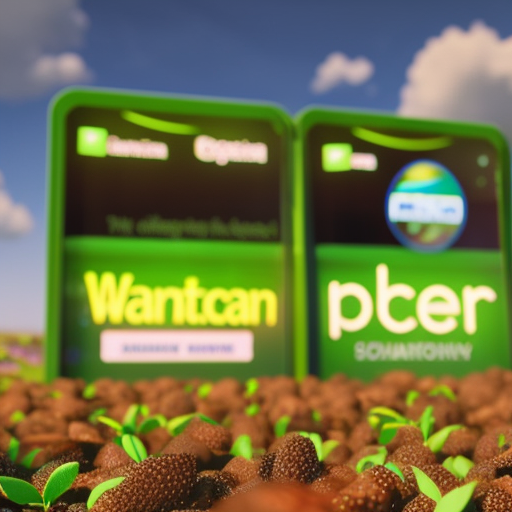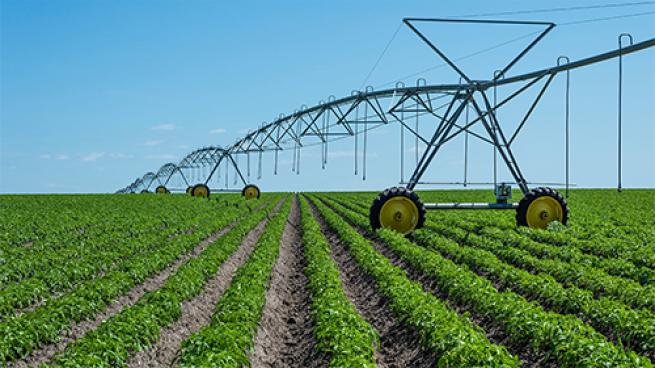PepsiCo, Walmart partner to support regenerative agriculture
PepsiCo, Walmart partner to support regenerative agriculture Drug Store News


PepsiCo and Walmart Collaborate to Support Sustainable Agriculture

PepsiCo and Walmart have formed a 7-year collaboration to pursue $120 million worth of investments focused on supporting U.S. and Canadian farmers in their pursuit to improve soil health and water quality.
By establishing and scaling financial, agronomic, and social programs, the collaboration aims to enable and accelerate the adoption of regenerative agriculture practices on more than 2 million acres of farmland. The goal is to deliver approximately 4 million metric tons of greenhouse gas emission reductions and removals by 2030, which is equivalent to the amount of electricity needed to power 778,300 homes for one year.
Embracing Regenerative Agriculture for a Sustainable Future
“From my perspective, embracing regenerative agriculture is essential,” said Jeff Huffman, owner and operator of Island Farms in Maxwell, Neb. “It’s good for farmers, not only because it’s beneficial to the environment and our food quality, but also for the profitability of our businesses. If you use less fertilizer and you grow a bigger crop, or if you use less water and can still grow the same size of crop, it strengthens your farm in a way that benefits the bottom line and our environment for generations to come.”
Collaboration for Sustainable Supply Chains
PepsiCo’s and Walmart’s businesses rely on farmers to grow ingredients used in their products. With a supply chain that spans North America and involves critical crops such as potatoes, oats, corn, wheat, soybean, and rice, sustainability practices need to be tailored to each commodity, region, and farm. The collaboration between PepsiCo and Walmart offers a voluntary and flexible approach to regenerative agriculture that recognizes the diversity of agriculture and the need for individualized solutions.
Supporting Farmers and Transforming Agriculture
“Successful sustainability starts and ends with trust. At PepsiCo, we work very hard to earn the trust of the farmer so they understand that we are investing in their legacy and they can hand their farm down to the next generation,” said Jim Andrew, chief sustainability officer at PepsiCo. “Farmers know their business better than anyone else, and what we hear from them is that for regenerative agriculture to make business sense, three things need to happen. They need economic support, social and cultural support, and agronomic support. This strategic collaboration with Walmart will advance our shared goal to have farmers’ backs as they transform farming in a way that benefits the planet and people.”
“At Walmart, our sustainability strategy is built to make the everyday choice the sustainable choice for our customers. This collaboration with PepsiCo is a great example of how we are prioritizing the expansion of regenerative agricultural practices among farmers across North America so that we can continue to make quality products affordable and accessible for customers. This collaboration aims to help elevate farmer livelihoods, engage them on how to more sustainably manage soil health, increase yields, and create a model that others can mimic across other product categories, including encouraging additional investments in regenerative agriculture by other brands,” said Jane Ewing, senior vice president for sustainability at Walmart.
A Shared Focus on Sustainability
PepsiCo and Walmart share a focus on supporting farming communities while improving soil and water health and lowering carbon emissions. PepsiCo aims to drive the adoption of regenerative agriculture practices across 7 million acres by 2030 and reduce absolute greenhouse gas emissions by more than 40% across its entire value chain by 2030. Walmart, as the largest convenient food and beverage company in North America, is committed to protecting, restoring, or more sustainably managing 50 million acres of land and 1 million square miles of ocean by 2030.
“This effort is a new model for PepsiCo, marking our first large-scale strategic collaboration focused on sustainable agriculture with a retail partner,” said Steven Williams, CEO of PepsiCo Foods North America. “Farmers are critical to our business, and many of the brands our consumers know and love rely on ingredients that we source straight from the farm. By joining forces with Walmart, we’ll be empowering farmers through education, upfront investment in outcomes, peer coaching, and cost-sharing—and hopefully inspiring others to join us.”
This collaboration between PepsiCo and Walmart exemplifies their commitment to the Sustainable Development Goals (SDGs) by promoting sustainable agriculture, reducing greenhouse gas emissions, and supporting farming communities. It serves as a model for other brands and retailers to invest in regenerative agriculture practices and contribute to a more sustainable future.
SDGs, Targets, and Indicators
-
SDG 2: Zero Hunger
- Target 2.4: By 2030, ensure sustainable food production systems and implement resilient agricultural practices that increase productivity and production, that help maintain ecosystems, that strengthen capacity for adaptation to climate change, extreme weather, drought, flooding, and other disasters, and that progressively improve land and soil quality.
- Indicator 2.4.1: Proportion of agricultural area under productive and sustainable agriculture.
- Indicator 2.4.2: Average income of small-scale food producers, by sex and indigenous status.
-
SDG 13: Climate Action
- Target 13.2: Integrate climate change measures into national policies, strategies, and planning.
- Indicator 13.2.1: Number of countries that have communicated the strengthening of institutional, systemic, and individual capacity-building to implement adaptation, mitigation, and technology transfer.
- Indicator 13.2.2: Number of countries that have communicated the mobilization of domestic financial resources in accordance with their national plans and priorities.
-
SDG 15: Life on Land
- Target 15.3: By 2030, combat desertification, restore degraded land and soil, including land affected by desertification, drought, and floods, and strive to achieve a land degradation-neutral world.
- Indicator 15.3.1: Proportion of land that is degraded over total land area.
- Indicator 15.3.2: Proportion of important sites for terrestrial and freshwater biodiversity that are covered by protected areas, by ecosystem type.
Table: SDGs, Targets, and Indicators
| SDGs | Targets | Indicators |
|---|---|---|
| SDG 2: Zero Hunger | Target 2.4: By 2030, ensure sustainable food production systems and implement resilient agricultural practices that increase productivity and production, that help maintain ecosystems, that strengthen capacity for adaptation to climate change, extreme weather, drought, flooding, and other disasters, and that progressively improve land and soil quality. | Indicator 2.4.1: Proportion of agricultural area under productive and sustainable agriculture. Indicator 2.4.2: Average income of small-scale food producers, by sex and indigenous status. |
| SDG 13: Climate Action | Target 13.2: Integrate climate change measures into national policies, strategies, and planning. | Indicator 13.2.1: Number of countries that have communicated the strengthening of institutional, systemic, and individual capacity-building to implement adaptation, mitigation, and technology transfer. Indicator 13.2.2: Number of countries that have communicated the mobilization of domestic financial resources in accordance with their national plans and priorities. |
| SDG 15: Life on Land | Target 15.3: By 2030, combat desertification, restore degraded land and soil, including land affected by desertification, drought, and floods, and strive to achieve a land degradation-neutral world. | Indicator 15.3.1: Proportion of land that is degraded over total land area. Indicator 15.3.2: Proportion of important sites for terrestrial and freshwater biodiversity that are covered by protected areas, by ecosystem type. |
Analysis
The issues highlighted in the article are connected to the following SDGs:
- SDG 2: Zero Hunger
- SDG 13: Climate Action
- SDG 15: Life on Land
Based on the article’s content, the specific targets under these SDGs can be identified as follows:
- Under SDG 2: Target 2.4 – Ensuring sustainable food production systems and implementing resilient agricultural practices.
- Under SDG 13: Target 13.2 – Integrating climate change measures into national policies, strategies, and planning.
- Under SDG 15: Target 15.3 – Combating desertification, restoring degraded land and soil.
The article mentions or implies several indicators that can be used to measure progress towards the identified targets:
- Indicator 2.4.1: Proportion of agricultural area under productive and sustainable agriculture.
- Indicator 2.4.2: Average income of small-scale food producers, by sex and indigenous status.
- Indicator 13.2.1: Number of countries that have communicated the strengthening of institutional, systemic, and individual capacity-building to implement adaptation, mitigation, and technology transfer.
- Indicator 13.2.2: Number of countries that have communicated the mobilization of domestic financial resources in accordance with their national plans and priorities.
- Indicator 15.3.1: Proportion of land that is degraded over total land area.
- Indicator 15.3.2: Proportion of important sites for terrestrial and freshwater biodiversity that are covered by protected areas, by ecosystem type.
The collaboration between PepsiCo and Walmart aims to improve soil health, water quality, and reduce greenhouse gas emissions through regenerative agriculture practices. This aligns with SDG 2’s target of sustainable food production systems and resilient agricultural practices (Target 2.4). The indicators mentioned in the article, such as the proportion of agricultural area under productive and sustainable agriculture (Indicator 2.4.1) and the average income of small-scale food producers (Indicator 2.4.2), can be used to measure progress towards this target.
The collaboration also addresses SDG 13’s target of integrating climate change measures into national policies, strategies, and planning (Target 13.2). The indicators mentioned in the article, such as the strengthening of institutional, systemic, and individual capacity-building for adaptation and mitigation (Indicator 13.2.1) and the mobilization of domestic financial resources for climate action (Indicator 13.2.
Behold! This splendid article springs forth from the wellspring of knowledge, shaped by a wondrous proprietary AI technology that delved into a vast ocean of data, illuminating the path towards the Sustainable Development Goals. Remember that all rights are reserved by SDG Investors LLC, empowering us to champion progress together.
Source: drugstorenews.com

Join us, as fellow seekers of change, on a transformative journey at https://sdgtalks.ai/welcome, where you can become a member and actively contribute to shaping a brighter future.







